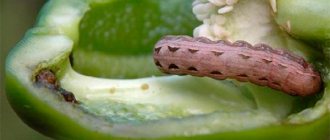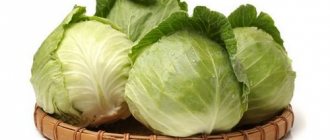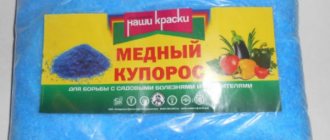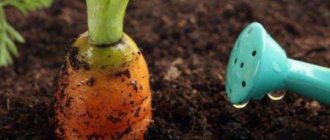We're not the only ones who love sturdy, green heads of cabbage. They are also eaten with pleasure by our competitors - all kinds of insects: butterflies, moths, slugs, fleas, etc. And diseases do not bypass cabbage. How to protect a healthy vegetable from misfortunes and illnesses?
You need to start protecting cabbage when no one and nothing threatens it yet - even before planting: preventive seed treatment will save you from some of the problems with growing cabbage in the future. And it is necessary to continue work throughout the entire growing season, right up to harvest.
- Photo identification of cabbage diseases and pests with descriptions and control measures
Want to quickly understand what's wrong with your cabbage and how to fix it? Especially for you, we have “squeezed out” the most important things.
How to soak cabbage seeds before planting
If you grow cabbage not from purchased seedlings, but from seeds, then you need to start fighting – preventively – against harmful fungi and bacteria even before sowing. To do this, use various biological fungicides. These drugs are not dangerous to humans, but are extremely aggressive against pathogenic fungi.
A three-hour soaking in Albit (dilute 1 ml in 1 liter of water) will protect the vegetable from pathogens of vascular bacteriosis. Two other drugs have a broader effect - Planriz and Sporobacterin. Both fungicides are used according to the same scheme: prepare a solution (dissolve 1 ml of the drug in 100 ml of water) and leave the seeds in it for 6 hours.
To prevent infection of cabbage with black leg, vascular bacteriosis and fusarium wilt, use Fitosporin-M (3 ml per 1 liter of water) or Trichoderma Veride (3 g per 10 liters of water). To process, soak the seeds in one of the solutions for 1-2 hours. After the procedure, thoroughly dry the planting material in the shade.
Among the folk remedies for pre-sowing treatment of cabbage seeds, disinfection in hot water is used. Place the seeds in a fabric bag and immerse them in hot water at a temperature of about 50°C for 20 minutes. After this, cool them by immersing them in a container of cold water for a few minutes. To dry, place the seeds in a cool, dark place for a day. You can also disinfect seeds in a warm solution of potassium permanganate by dipping them there for half an hour before planting.
- 15 secrets of growing good cabbage seedlings
Do you know everything about growing cabbage seedlings? Check yourself and don't make mistakes!
From aphids
Cabbage aphids damage young plants. You can protect vegetables from pests in the following ways:
- Prepare a complex infusion: mix 1 glass of ash, tobacco dust and 1 tbsp. l. liquid soap, mustard. Fill with a bucket of hot liquid (10 l), let it brew for a day. Strain and sprinkle the mixture over the heads of cabbage.
- Dissolve 400 g of crushed soap in 10 liters of liquid. Treat the plants with the resulting soapy water using a spray bottle.
- Make an ash-soap solution: pour boiling water (1 liter) over ash (1 tablespoon), stir and leave overnight. Strain, add liquid soap (a few drops), spray the cabbage with the product in the morning (at 5-6 o’clock), paying attention to the lower part of the leaves. The procedure should be repeated every other day.
- Strudel with cherries - how to cook at home using step-by-step recipes with photos
- Manti recipes with photos
- Transfer to a Sberbank card via SMS using Mobile Banking, USSD command or short number
Pre-planting tillage
To get a good cabbage harvest, you need to take care not only of the seeds, but also of the soil. For example, there are no chemical drugs to treat such a terrible disease as clubroot. The only way to help cabbage is to prevent the disease from occurring. This cannot be achieved without preventive measures. Clubroot develops rapidly at high temperatures and humidity and when cabbage is grown in acidic soils. If we cannot change the weather conditions, then we can easily cope with the acidity of the soil. If you have acidic soil and you have not limed it in the fall, then 7 days before planting the seedlings in a permanent place, treat the soil with Bordeaux mixture (dilute 10 tablespoons in a bucket of water), and then add ash to it. You can also add 20 g of slaked lime or chalk to each hole during planting.
If you find signs of clubroot, then the only thing you should do immediately is remove the cabbage from the garden bed and burn it along with the roots and soil. Water the bed where the diseased plants grew with a saturated solution of potassium permanganate.
- Clubroot cabbage - how to deal with a dangerous disease
We tell you how to get rid of clubroot on cabbage once and for all.
How and when to treat cabbage against pests
Pests can be driven away from plants, or prevented from entering the garden bed at all, using various methods. These include both biologically pure methods of control, using infusions and decoctions of plant materials, and spraying cabbage with chemicals.
Among gardeners there are adherents of both methods. Both biological and chemical methods of control can be used, but with the chemical method it is important to observe the timing between processing vegetables and eating them. Failure to comply with the recommended interval is dangerous to human health.
How to process cabbage seedlings
Already at the germination stage, signs of some diseases begin to appear.
One of the most dangerous diseases of all cruciferous crops is vascular bacteriosis. It can make itself felt at any stage of cabbage growing. The plant's leaves darken and die - it dies. To combat the disease when 3-5 true leaves appear, use the biological product Albit (1 ml per 10 liters of water). Repeat spraying twice more with an interval of 15 days.
A disease such as blackleg can also cause the death of seedlings. Even if the plant survives, it will still grow worse and produce a smaller harvest. The cause of black leg is excessive soil moisture and growing cabbage in the same place for several years. To prevent the appearance of the disease, in the phase of 2-3 true leaves, water the seedlings at the root with Trichoderma veride (25-50 g per 10 liters of water).
Before planting in a permanent place, treat the soil again with Trichoderma veride, adding 100-150 ml of the prepared solution to each hole.
If you used Fitosporin-M at the initial stage, when soaking the seeds, then continue to use it further. 1-2 hours before planting in the ground, dip the roots of the seedlings in a solution (4 ml per 1 liter of water) of this drug. It will protect young plants from both blackleg and Fusarium wilt. 7-10 days after planting, repeat the treatment with Fitosporin: spray the plants with a solution of the drug (10-15 ml per 10 liters of water). Carry out another spraying after 2-3 weeks.
Immediately when planting seedlings, do not forget to take care of protecting your plantings from cabbage pests. To prevent the appearance of cabbage fly, add 30 g per 10 sq.m. of one of the preparations to the soil: Medvetox or Zemlin. To combat ants, which cause considerable harm to all garden crops, use Ant (3 g per 1 sq.m.). After applying the preparations, loosen the soil so that all the granules are under a small layer of it.
When planting seedlings in a permanent place, powder the leaves of the plants with ash or tobacco dust.
Prevention measures
Various insecticides can be used as prevention, but supporters of organic farming use other equally effective methods. They are distinguished by their harmlessness and can easily scare away annoying and voracious pests.
The smell of some plants repels harmful insects; in addition, these flowers, herbs and other plants have extensive practical applications. Fans of herbal teas will definitely appreciate such clever techniques, because most of these plants can be brewed and stored for future use.
To prevent cabbage and other plants from being taken over by pests, the following can be planted on the beds themselves or near them: mint, thyme, lavender, wormwood, marigolds, pyrethrum daisies, onions, lemon balm; garlic and other fragrant herbs and plants. Such useful plantings will reliably protect the beds from harmful insects, but if “uninvited guests” still made their way onto the site, then you can use any of the folk recipes for pest control.
Folk remedies for protecting cabbage from pests are considered the most effective
How to process cabbage during the growing season
The seedlings begin to grow, and at the smell of their favorite delicacy, all sorts of enemies of the healthy vegetable crawl and flock from everywhere. It's time to start a merciless fight against them.
Treatment for cabbage whites (cabbage)
Cabbage white (cabbage) is a real disaster for cruciferous vegetables. It is not the butterfly itself that causes harm, but its larvae - insatiable caterpillars. If you don’t start fighting them in time, then instead of cabbage leaves you will find only remains that have been gnawed down to the veins.
The most effective way is to collect all the caterpillars by hand. In large areas where this is quite problematic, we recommend using the following folk remedies:
- Dissolve 100 g of mustard powder in a bucket of hot water and leave to steep for a week. Spray the cabbage with the resulting solution.
- Pour about 1 kg of chopped potato tops into a bucket of water and leave for 3 hours. After this, strain and add 50 g of soap to the solution.
- If you have small areas planted with cabbage, you can protect the plantings with either covering material or fine mesh to prevent the insect from laying eggs.
Cabbage moth treatment
The cabbage moth is not far behind the whiteweed. Its larvae (caterpillars) can be found not only on the outer leaves of cabbage (they turn pale and dry out), but also inside the heads of cabbage. To cope with the pest, prepare an infusion of red elderberry. Chop 300 g of flowers and young shoots and pour a bucket of boiling water. Insist for a day. After this, strain and spray the cabbage captured by the harmful insect.
Cabbage cutworm treatment
The nocturnal moth, the cabbage moth, also causes a lot of harm. She, or more precisely, her larva - a caterpillar, operates mainly inside the head of cabbage. After the scoop, its entire interior is dotted with winding passages, inside which the caterpillar leaves its own excrement, causing the scoop to rot. In order not to be left without a harvest, the fight against cabbage cutworms should begin when the first caterpillars appear. It is better to combine two methods: manual collection of caterpillars and spraying with garlic infusion. To prepare it, pour 150 g of chopped garlic into 1 liter of water. After a day, strain, dilute another 4 liters of water and sprinkle the entire cabbage with the infusion.
Treatment for cruciferous flea beetle
Another formidable enemy of cabbage is the cruciferous flea beetle. Both larvae and adults cause damage by gnawing leaves, stems and roots. A plant damaged after a flea infestation begins to hurt. To protect against pests, we recommend covering the plantings with any non-woven covering material. If the enemy has already made its way, dust with any of the following compounds: slaked lime and wood ash or tobacco dust and ash. Mix the components in a 1:1 ratio, place them in a gauze bag and pollinate the cabbage plantings every few days. It is better to carry out the procedure in the morning, before the dew has dried on the leaves.
- Folk remedies for cabbage pests - how to treat plants
We’ll tell you how popular rumor and experience advise dealing with cabbage pests.
If folk remedies do not help and pests continue to destroy head after head of cabbage before your eyes, we recommend using chemicals. The following insecticides are suitable to combat these and other cabbage enemies: Shar Pei (1.5 ml per 10 liters of water), Iskra Double Effect (1 tablet per 10 liters), BioKill (4 ml per 5 liters), Alatar (5 ml per 4 l), Aliot (10 ml per 10 l), Antitlin (500 g per 10 l), Herold (1.5 ml per 10 l), Fufanon-Nova (13 ml per 10 l), Iskra-M (10 ml per 10 l) and others.
There are also several biological insecticides that can help control some cabbage pests.
Bitoxibacillin (40-50 g per 10 liters of water) will help against cabbage scoop. Spray cabbage with it at intervals of a week, destroying each new generation of the pest. To combat cabbage grass, cutworms and moths, use Fitoverm (1.6 ml per 10 liters of water) - maintain an interval of 20 days between sprayings. Lepitotsid has the widest spectrum of action (20-30 g per 10 liters of water). Treatment is allowed at intervals of a week.
Treatment for slugs and snails
In addition to flying pests, there are also crawling ones - slugs and snails, hordes of which are especially active in wet weather. You can fight them in several ways.
The first way is to collect snails and slugs by hand and destroy them without mercy. The second method is more humane - scatter any material with sharp edges on the cabbage beds: eggshells, small pebbles, fragments of the shells of their dead counterparts, etc. Due to the fact that the pests have a very sensitive abdomen, they will not be able to crawl to the cabbage on such a rough surface. Another method is based on the craving of harmful shellfish for beer. Dig disposable plastic cups around the perimeter of the cabbage plantings. Pour a little beer into each. After a day, you can collect drowned snails and slugs. Alcohol will never do anyone any good!
Chemical scientists offer their drugs to combat crawling pests: Thunderstorm (30 g per 10 sq.m.), Slug Eater (30 g per 10 sq.m.) and Predator (7 g per 10 sq.m.). All these granular preparations are scattered on rows, paths and in close proximity to cabbage plantings.
- How to get rid of slugs on your property - effective pest control measures
Find out what slugs are afraid of and how to deal with their infestation.
Treatment of cabbage against diseases
From the very beginning of the growing season until storage, cabbage - both seedlings, seeds, and heads of cabbage - is attacked by all kinds of diseases: downy mildew (downy mildew), fusarium wilt of cabbage, white and gray rot, various bacterioses, etc. To combat them, use biological preparations .
Sporobacterin, in which the seeds were soaked, is also effective during the growing season. Dissolve 1 ml in 1 liter of water and spray cabbage with it when the first signs of any disease appear. Repeated treatment can be carried out after 20 days.
Using the same scheme, you can treat plants with the biological product Planriz (mix 10 ml with 10 liters of water).
What insects harm cabbage, principles of combating them
Every gardener who grows cabbage knows: cruciferous flea beetles are terrible for newly planted seedlings and young bushes. The cabbage fly also greatly harms them. As soon as the cabbage grows, white butterflies begin to circle over the beds. But this is during the day, and at night cabbage cutworms look for places to lay eggs.
Beautiful moths or butterflies that fly to the light seem harmless, but for the most part they are pests
There are also permanent residents on cabbage - naked slugs; they grow and develop in the garden bed throughout the warm season, and in the fall they even try to climb inside the heads of cabbage to lay eggs there. Some gardeners complain about aphids. To cope with all these parasites, you need:
- Study the habits of pests, which are quite primitive.
- Choose effective means of prevention and control.
- Apply these remedies in a timely manner.
To process cabbage you will need: a sprayer and good preparations, but there are many ways to do without them
At the very beginning of the fight against any pests, you need to understand that there are systemic and contact drugs. Systemic ones are absorbed by the plant and carried with its juices to all parts, including even the root. The pests will die as soon as they start feeding on the treated cabbage. Contact ones kill by contacting the insect directly; the plant itself does not become poisonous. This group includes folk remedies. To many they seem ineffective, which is logical, because it is impossible to spray literally every flea, caterpillar or egg.
The recipes that gardeners share among themselves are best used as prevention. Namely, this is where you should start, without waiting for a problem to arise. If it didn’t work out, the deadlines were missed, insects have already settled on the cabbage and are actively eating it, then proceed to extreme measures - treatment with systemic insecticides.
Harvesting and processing of the finished crop
For better preservation of the grown crop, it must be properly removed and processed before storage. It is necessary to harvest cabbage in dry, cool weather. Only varieties with medium and late ripening periods are suitable for long-term storage. Early ripening cabbage should be used as quickly as possible.
To prevent spoilage (cabbage is susceptible to rotting and drying out during storage), treat cut heads with crushed chalk (200 g of chalk per 10 kg of vegetables). Similar treatments should be repeated each time spoiled leaves are removed.
- Storing cabbage - what diseases can ruin the harvest?
Improper storage of cabbage can lead to dire consequences.
In addition to the above measures, when growing cabbage, do not forget to remove weeds and plant debris in a timely manner, follow the agricultural techniques for growing the vegetable and do not neglect crop rotation.
How many days later can I eat cabbage after treatment?
After spraying the cabbage with herbal infusions or decoctions, the vegetable can be safely eaten both after heat treatment and fresh. Unless you have to, after spraying with bitter infusions, before using cabbage in cooking, remove the top leaves from the head of cabbage. After treatment with any chemicals, vegetables cannot be eaten for quite a long time.
Find out if cabbage contains starch.
The minimum waiting period between processing and consumption for food is 14 days. Cabbage is a tasty and healthy vegetable, and gardeners should take measures to protect their cabbage beds from pests in order to get a harvest of large and juicy cabbage heads in the fall.
How to use natural products correctly
In order for home-prepared preparations to be highly effective and not harm plants, they must be used correctly. There are several important rules for using natural remedies for cabbage pests:
- Spraying with any composition is carried out only in the morning or evening, until the sun begins to bake the cabbage leaves.
- Almost all folk remedies are not very durable, so they will have to be used after every rain, and to get rid of pests, several procedures will be required at intervals of 5-7 days. Recipes must be alternated to achieve the desired effect.
- If, after using traditional methods, the pests have not disappeared or even become more numerous, then it is worth treating the cabbage with insecticides or biological products as soon as possible, otherwise you may lose the harvest.
- When used correctly and in a timely manner, all folk remedies show high effectiveness, strengthen the immunity of plants and protect their subsequent infection.











